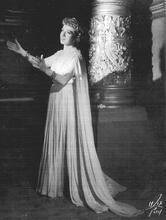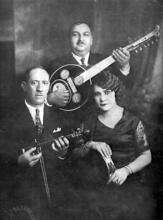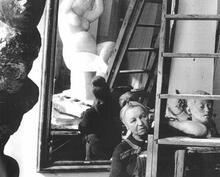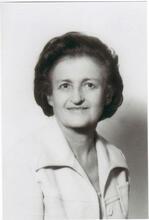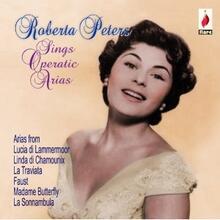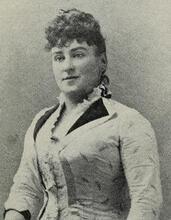Flory Jagoda
Singer, musician, and composer Flory Jagoda has widely promulgated and enriched the Sephardic musical tradition in the United States. Born in 1923, in Sarajevo, she was raised in a Ladino-speaking and musical extended family and a grandmother who sang Sephardic songs and recited traditional prayers. Flory escaped from Nazi-occupied Yugoslavia but most of her family perished, murdered by the Fascist Croatian Ustasha and buried in a mass grave. After the war, Flory made a made a home and family in the United States. Since the 1970s, she has dedicated herself to performing, recording, and teaching the music of her Bosnian childhood and her own compositions, including the globally popular Ocho Kandelikas. She had become everybody's nona by the time she was 80. Two documentaries and a children's book document and honor Flory's life and career.
In the world of Sephardic music, Flory Jagoda was a superstar. Singer, musician, composer, mentor, performer, beloved mother and nona (grandmother), she is known as “The Keeper of the Flame” for her commitment to preserving the traditions and Ladino language and music of her Sephardic heritage. She regaled listeners with the stories of her Bosnian family and introduced their songs to audiences around the world.
An old Ladino saying states that if “Bosnia is bread, Jews are neither the flour nor water–but they are the Salt.” Jagoda, one of the surviving Jews of Bosnia after World War II, added that special spice with her stories, her music, and her voice.
Family Background
Flory Jagoda, née Papo, was born in Sarajevo, Bosnia, on December 21, 1923, to Rosa Altarač/Altaras and Samuel Papo, a musician who played in local nightclubs. Rosa and Samuel’s marriage lasted only a year, and after they separated Rosa and daughter Florica (Floritza) returned to her parents’ home in the mountain village of Vlasenica in northeastern Bosnia, accompanied by the scandal of being the first divorced woman in her family. Flory spent a happy childhood in Vlasenica surrounded by loving aunts, uncles, cousins, and her beloved Nona and Nonu (grandfather). Rosa’s family proudly traced their history from Spain. As a child, Flory learned about the 1492 Edict of Expulsion issued by Queen Isabella and King Ferdinand, about the Spanish Inquisition, and that the Descendants of the Jews who lived in Spain and Portugal before the explusion of 1492; primarily Jews of N. Africa, Italy, the Middle East and the Balkans.Sephardim were forced to convert to Christianity or flee the Spain they had loved for 700 years.
Jagoda also learned the legend of “La Yave,” the Key that each Sephardic family carried into exile, handing it from one generation to the next with the dream of returning one day to their homes in Spain. She composed and recorded the haunting “La Yave De Espanya” (The Key From Spain) on her second album, Memories of Sarajevo.
Jagoda’s ancestors, the Altarac family, journeyed from Cordoba to the welcoming Ottoman Empire; by 1565, a merchant trader named Avram Altarac lived in Sarajevo (Altaras in Spanish became Altarac in Bosnian). By the 1800s, the Altarac family had relocated from Sarajevo to Vlasenica; by 1884 they had established a successful store and vibrant trading business. In the early twentieth century, Flory’s Nonu, Sambul Altarac, and his two brothers sat on the Vlasenica town council with the town’s Muslims and Greek Orthodox elders. The harmony between Muslims, Catholics, Greek Orthodox, and Jews throughout Bosnia lasted until World War II.
Formative Years in a Musical Family
Jagoda’s love of music and storytelling was nurtured by her family in Vlasenica, especially by her loving Nona, Berta Altarac, known for her beautiful singing voice and her adherence to Sephardic customs and religious law as well as for being the region’s midwife and herbalist. Nona’s motto was “Si nu puedis meter la alma, nu kantis!” (If you can’t put your soul into your songs, don’t bother singing). Flory shared that sentiment all her life.
In her Songbook, Flory wrote: “All the enduring feelings that I have for my Sephardic culture, its stories and especially its songs were a loving gift from Nona to me. She taught her daughters and granddaughters all the women’s Birahas and Bendiziones (prayers and benedictions) that she learned from her own Nona and Biznona (grandmother and great grandmother). Included in her teachings was the important tenet of Ts’daka (charitable acts). Just before every Shabbat evening, my cousins and I would hurry home from school to take baskets of food that Nona had prepared for the poor. Nona would admonish us in her Bosnian Judeo-Espanol ‘Nu asperis ke ti digan grasyas – soz mazaloza ke poidis dar’ (Don’t wait for them to say thank you, you are fortunate that you are able to give).” Jagoda wrote Rikordus Di Mi Nona (Remembrances of My Grandmother) and dedicated it to her Nona on her 2005 CD Arvoliko (Little Tree).
Music was an integral part of the life of the Altarac family, whose talented members were invited to perform at every festival. On her third CD, La Nona Kanta (The Grandmother Sings), Flory dedicated an original song to her five aunts (Laz Tiyas) and the holidays celebrated at each Tiya’s house.
Flory lived in Vlasenica with her Nona and the Altarač family until she was eleven. When her mother remarried a fellow Sephardic Jew, Michael Cabiljo (Kabilio), Flory joined the couple in the capital Zagreb, where she attended school and took piano, art, theater, and ballet classes.
A pivotal point in Flory’s life occurred when Michael bought her a Hohner accordion (Harmoniku), the instrument she had always dreamed of playing. Her Harmoniku became her most cherished life-long friend. With time, Flory adjusted to city life, but she looked forward to her summer vacations in Vlasenica, enjoying Nona’s cooking, stories, and songs and speaking "djidio" (Jewish, as Judeo-Spanish was called in Bosnia) surrounded by the family she loved.
Surviving World War II
In 1941, the Second World War brought great terror to Yugoslavia’s Jews. Of the 82,500 Jews living in the country at the time, only 14,000 (17%) survived the Holocaust. Soon after the Nazis marched into Zagreb in April 1941 and the restrictions on Jewish life escalated, Michael secured false identification documents and train tickets for an escape from Zagreb to Split, a beautiful old city held by the Italian army on the Adriatic coast. Flory was sent first, alone, carrying one suitcase and her cherished harmoniku. Her father’s directive as she left their apartment for the train station was “Get on the train and just play your harmoniku” (Sviraj Harmoniku). For four hours, from Zagreb to Split, Flory accompanied herself on the harmoniku and sang songs in Serbo-Croatian, to the delight of the passengers and the conductor, who never asked her for her papers. Rosa and Michael reunited with Flory in Split, and from there, the Italian Army sent the Jews to various islands for safety.
Flory and her parents and 500 other Jews were sent to the Island of Korcula, where they lived until the autumn of 1943, when Italy broke its alliance with Germany. Rather than hand them over to the Germans, the Italian soldiers helped the interned Jews escape across the Adriatic to Bari, Italy, in fishing boats in the dead of night. Flory recalls the kindness of the Italians who lined the shore waiting with baskets of food for the small fleet of boats carrying the terrified refugees to safety. The Italian and basic English they had learned in makeshift schools on Korcula helped them make a life in Italy.
Marriage and Family’s Fate
Working as a translator for the American Army, Flory met and fell in love with Sergeant Harry Jagoda. Delighted to find out Flory was Jewish, he asked her parents for her hand in marriage. Harry, who was in charge of salvage, secured half a silk parachute, which provided the material for Flory’s wedding dress and trousseau. On June 24, 1945, the American army hosted their wedding, with Harry’s entire 225th Quartermaster Company and most of the Jewish refugees in Bari in attendance, complete with a homemade bridal canopyhuppah, a Rabbi flown in from Naples, and an Army band. The only thing missing was her Altarac family.
On the couple’s return to Bari after their honeymoon, they learned that of the entire family in Vlasenica, only Rosa, Flory, Lezo, and a cousin had survived the war. Forty years later, on a trip to Vlasenica with Harry to visit Uncle Lezo’s daughter Berta (named for her Nona), Flory finally learned the tragic truth. Vlasenica’s 60 Jews, including 42 members of her beloved Altarac family, had been rounded up by the Ustasha (Croatian fascist terrorist organization aligned with the Nazis), tortured, murdered in a ravine outside their village on May 6, 1942, and buried in a mass grave. The title song in Flory's CD Arvoliko (The Little Tree) is about the tree that was the only marker of the mass grave until a memorial stone was placed in 2011.
A New Life and Family in America
At the age of 22, Flory started a new life in America with her husband. Harry returned to the United States first after being discharged from the Army; Flory joined him four months later in April 1946, travelling to New York City on the Red Cross ship “Algonquin” with her harmoniku and 300 other war brides. The couple spent their reunion night as guests of New York City’s Hotel Lincoln, in the bridal suite, unexpectedly paid for by the hotel management with gratitude for Harry’s service in the war.
Harry’s Ashkenazi family, originally from Poland, spoke Yiddish at home. While Flory did not know Yiddish, it was close enough to the German she had learned at school for her to fit in. Harry’s parents, Rachel and Morris Jagoda, warmly welcomed her into their family in Youngstown, Ohio. After living a year in Youngstown, Harry and Flory moved to Washington, DC. Flory loved the city with its bridges, sculptures, European layout, and wonderful museums. Flory took art classes at the Corcoran Gallery, found musicians to play with, and formed lifelong friendships with other Europeans, especially musicians in the DC area. Art and music continued to frame her life.
Harry focused on building a business career and supporting their growing family. In the late 1950s he and Frank Weinstein formed Maywood Builders, a construction partnership that lasted over 40 years. Flory began giving music lessons (piano and accordion), studying classical guitar, and raising her children: Betty, born in 1947, Elliot, born in 1949, and Andy, born in 1952. The family joined a conservative synagogue, Arlington-Fairfax Jewish Center (now Etz Hayim), where the children attended religious school and her sons became Lit. "son of the commandment." A boy who has reached legal-religious maturity and is now obligated to fulfill the commandmentsb’nai mitzvah. In 1956, the family moved to Falls Church, Virginia. Flory and Harry’s fourth child, Lori, born in 1959, completed the family.
By the 1960s, Flory was the center of a robust group of musical friends. There were monthly Song Swapper meetings, folk dancing get-togethers, lamb roasts, and holiday parties, always with people playing instruments and speaking myriad foreign languages or English accented with the sounds of the world. Flory was one of the founders of the Jewish Folk Arts Society and was always a featured performer at its yearly festivals.
Although Flory’s parents came to the United States in 1948, Rosa never truly recovered from the terrible news of her family’s massacre. For the rest of her life she refused to speak Judeo-Spanish or sing the songs, and she told Flory that for her, the language had died with her family. Their grandchildren called them Grandma and Grandpa instead of Nona and Nonu. For the most part, the Jagodas celebrated holidays structured by Harry’s Ashkenazi traditions, prayers, and foods. Flory became a proud American patriot, emotional at July 4th parades, and raised her children to be American, speaking only English and living a fully American Jewish life. Like many Holocaust survivors, she suppressed her memories of her life before the terror of the war years.
Reclaiming Her Roots, Musical Success and Influence
After Rosa’s death in 1972, Flory began looking through the photographs of the Altarac family her Nona had given her before she left Vlasenica for Zagreb in 1934. With memories flooding back, she began writing down songs and stories. She wanted to share with her children the family she had known and to pass down the songs and history that had formed the structure of her life. All the children enthusiastically began to learn the family songs. The children picked up the rhythms and harmonies of the Ladino songs and added their guitars, drums, tambourines, castanets, finger cymbals, and clapping. They learned the “old” songs and the new ones that Flory wrote to honor her lost family and her war experiences, as well as sweet songs she composed for her grandchildren and to celebrate holidays. Ocho Kandelikas (Eight Little Candles) was an immediate hit and became one of the best-known Hanukah songs all over the world. Her son Andy and his wife, Silvana, both physicians, added their voices to Flory’s on the recording of Ocho Kandelikas.
“Flory Jagoda and Family” gave their first “official” concert to a full house in Washington, DC, at the intimate Sixth & I Historic Synagogue in 1982. Flory was soon in demand for cantorial workshops, lectures, and panel discussions. Until 2016, she performed worldwide as a featured soloist at universities, synagogues, concert halls, museums, and festivals. She was often joined by her children in concerts across the United States and in tours through the former Yugoslavia in 1985, Spain in 1994, and Vienna in 1999. Singer and guitarist Susan Gaeta became Flory’s apprentice in 2002 through a grant from the Virginia Foundation of the Humanities (VFH); their performances were often accompanied by Howard Bass on guitar. Gaeta, Bass, and Tina Chancey have expanded on Flory’s legacy as “Trio Sefardi.” Cantor Aviva Chernick was Flory’s second apprentice through the VFH and has recorded several of Flory’s compositions.
Many singers and musicians worked with Flory to learn her songs and perform them in concert, both with her and on their own. When Flory was awarded a National Heritage Award from the National Endowment for the Arts in 2002, she felt she had reached the height of her career. In 2003 she was awarded the Immigrant Achievement Award.
A Special Bond with Ladino Speakers
To connect with Ladino speakers worldwide, Flory subscribed to the group Ladinokomunita soon after the group was founded in 1999. She also shared her music and culture with people in the Greater Washington area who could understand and speak Judeo-Spanish and were interested in gathering for afternoons of conversation, konsejas (stories), and songs. She organized monthly Vijitas Del Alhad (Sunday Visits), always with Sephardic food and songs and stories in Ladino.
In March 2003, Flory was the invited soloist at the dedication of the memorial plaque in Ladino at Auschwitz. Her a cappella rendition of the Ladino traditional Arvoles Yoran por Luvias (Trees Cry for Rain) brought the crowd to tears. Sephardic inmates of the death camp sang this song because its refrain “Torno i digo ke va ser de mi; en tierras ajenas yo me vo murir” (I turn and say, what will become of me; I will die in a strange land)—which they sometimes also sang as “en tierras de Polonya yo me vo murir” (I will die in the Polish lands)—profoundly reflected their demoralized state.
Documentaries, Awards, and Recognition
Oral history with Ladino musician and composer Flory Jagoda, Library of Congress, 2013.
Flory Jagoda live in concert, 2014.
Two documentaries, The Key From Spain and Flory’s Flame, have been produced about Jagoda’s life and music and screened at film festivals and private showings worldwide. For her lifelong devotion to Ladino music and her efforts to preserve and enhance this unique repertoire, she has won recognition from the National Endowment for the Arts in 2002, the American Immigration Law Foundation in 2003, the Zamir Choral Foundation with its Hallel V’Zimrah Award in 2015, and countless other organizations. She has been interviewed, videoed, and written about, most recently by author Debbie Levy in the 2019 children’s book The Key From Spain.
On September 21, 2013, a Celebration Concert for Flory took place at the Library of Congress. Flory and her family, including her granddaughter Ariel and a stage full of musicians who had been mentored by and had performed with Flory, came together to sing her songs and hear her tell her stories to a sold-out audience celebrating her 93rd birthday. The Celebration Concert formed the foundation for the documentary Flory’s Flame, which premiered on December 6, 2014, during the International Ladino Day Festivities at The Stroum Jewish Community Center in Seattle.
Throughout her performing career Flory captivated her audiences. A small beautiful woman with a soft and kind voice, she radiated serenity. Before each song in every one of her programs, she told a story about the song or the family that sang it, enticing everyone in the audience to be part of her family and join in singing the lyrics to the classics such as Adiyo Kerida, Ocho Kandelikas, and many others. She composed songs to honor the legacy of her family and to celebrate her grandchildren. She viewed Ladino as a living, expressively beautiful language and wanted the world to see it through her eyes–full of the love for the culture that survived the Spanish Inquisition and the Holocaust. She had become everyone’s Nona by the time she was in her 80s. As her late son, Elliot, lovingly described her, “She is the ‘IT’ of Sephardic Culture.”
Flory Jagoda passed away on January 29, 2021.
Discography
Kantikas Di Mi Nona: 3/17/1981
Six compositions: Pesah Ala Mano, La Kapara, Los Siete Ijos di Hana, Ocho Kandelikas, Hamisha Asar, Klaro Del Dya,
Memories of Sarajevo: 6/23/1983
Seven compositions: Andemos Al Kafe, Simhat Tora, La Yave de Espanya, Yo Hanino Tu Hanina, Le Diya de Purim, Madre Miya Si Mi Muero, Ken Kere Tomar Konsejo,
La Nona Kanta: 6/20/1992
Nine compositions: Buen Shabat, Laz Tiyas, Chiko Ianiko, Luz Primuz Ermauz, La Parida, Ariel, La Mezuza De Aroniko, Hanuka Hanuka, L’Amor,
Arvoliko: 8/13/2005
Three compostions: La Biraha De La Mujer, Rikordus Di Mi Nona, Arvoliko,
Kantikas Di Amor I Vida (with Cantor Ramon Tasat): 2006
Videos
The Key From Spain: The Songs and Stories of Flory Jagoda, A documentary film by Ankica Petrovic (2002).
Flory's Flame. A documentary film by Curt Fissel and Ellen Friedland (2014).
The Flory Jagoda Songbook: Memories of Sarajevo. New York: Tara Publications, 1993.
Personal memories of Betty Jagoda Murphy and Rachel Amado Bortnick.
Further reading:
https://virginiafolklife.org/sights-sounds/flory-jagoda-and-aviva-chernick/
https://virginiafolklife.org/sights-sounds/florys-accordion-apprenticeships-merge-as-dale-wise-accordion-master-artist-restores-flory-jagodas-accordion/
Oral Interviews
https://virginiafolklife.org/sights-sounds/flory-jagoda/
https://collections.ushmm.org/search/catalog/irn504836
https://www.youtube.com/watch?v=FQ-C2SRDlv0




